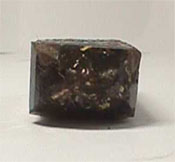The Story of Zircon Gemstones

Zircon
Consumer Information
What color is it?: Generally brown to a reddish brown as shown by the zircon crystals below. However, when heated the stone becomes a beautiful blue color. And can also occur colorless. The green variety is usually a type that has degenerated due to radioactive elements inside. (don’t panic, well talk about this later!)
What is the story behind this gemstone?: Zircon has been around in jewelry for hundreds of years. It is known for its high dispersion and for many years was used to imitate diamonds. Today it is available in several colors, one of the rarest of which is the mauve color shown above.
Can I wear it everyday?: Generally yes. But be aware that it can be brittle and will show abrasions on the facet junctions fairly easily. So don’t wear it if you are working in the garden, framing houses, or anything like that.
Is it expensive?: No. Brown and blue zircons will sell for about the same price as a medium range amethyst.
Is it a birthstone?: No.
What do I need to know before going shopping?: Be prepared to shop around for a nice stone. Natural zircons are a great addition to anyone’s jewelry wardrobe if you wish to add a nice conversation piece. And the wide array of earth tone brown colors make for some nice complimentary jewelry items.


General Information
Source: Burma, Thailand, Sri Lanka are major sources. Others possible.
Chemical: Zr(SiO4) Zirconium Silicate
Formation: Igneous rocks
Crystal System: Classic tetragonal. Should be studied by FGA students as this one is almost always on the Diploma Practical Examination for crystal identification.
Unusual Properties: Strong double refraction. Color is caused by presence of thorium and uranium. Two radioactive elements that if present in enough proportions can cause crystals to degenerate to what is known as metamict crystals. Virtually all stones on the market are not dangerous and carry little residual radioactivity. I tested all of the stones shown here with a CDV-700 Geiger counter and all were inert.
Gemological Information
RI: 1.777 – 1.984 ….Note: The refractive index can vary widely. Zircons with higher readings are called high zircons while those with lower RI readings will be called low zircons. The difference is the amount of crystal degeneration due to the presence of radioactive materials.
Birefringence: .059 is fairly standard regardless of RI readings
Optic Character: U+
Specific Gravity: 3.90 to 4.71 depending on low zircon or high zircon
Hardness: 7 average
Transparency: TP to TL
Special Identifying Properties and Tests: Easily identified by its RI being over the limit of most refractometers and its strong double refraction. Not much else can touch it for double refraction in the brown or blue colors so you should be able to identify this one fairly easily with a loupe.
Synthetics: None known at this time. Nor any reason anyone would want to.
Imitations: Many possible from a distance. None can imitate the DR up close.

